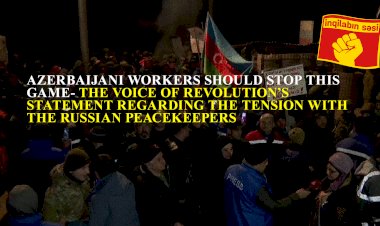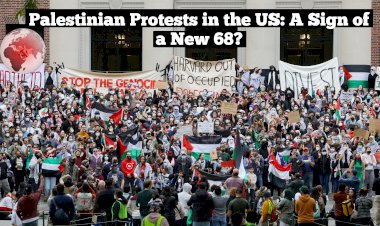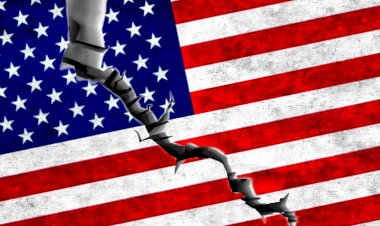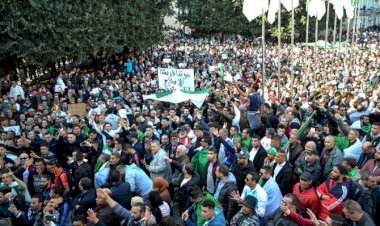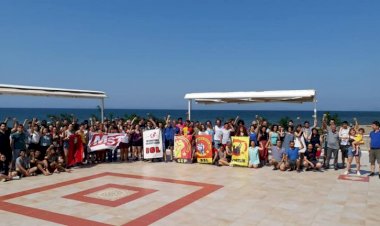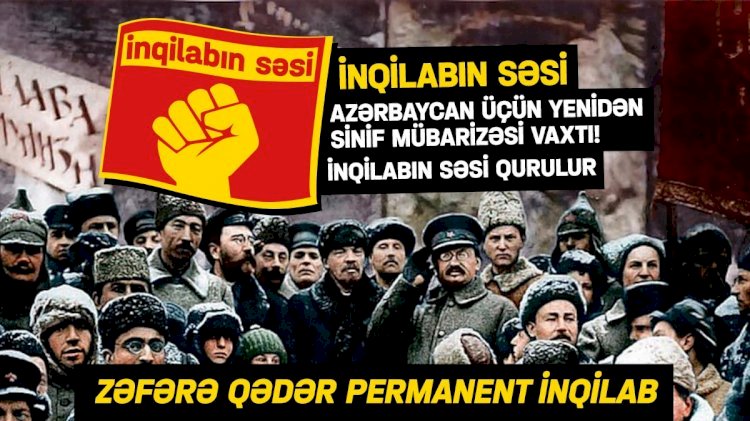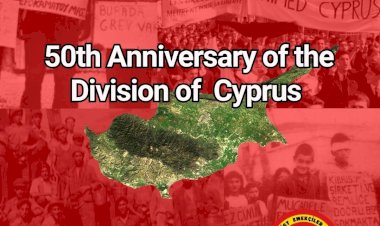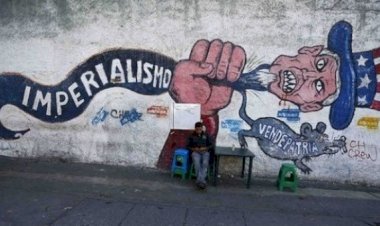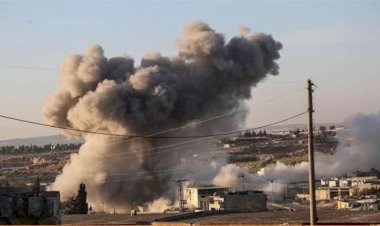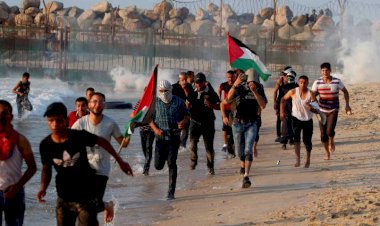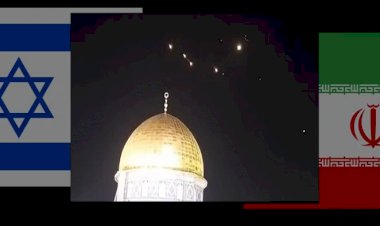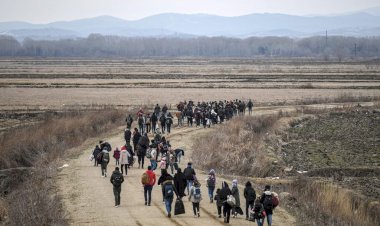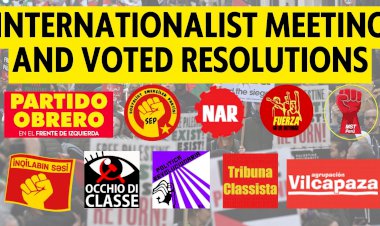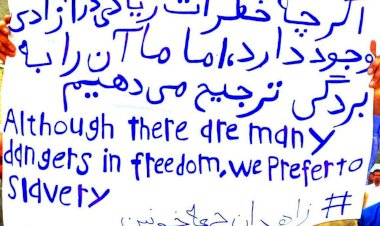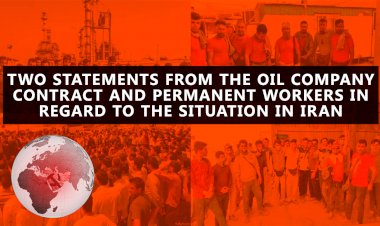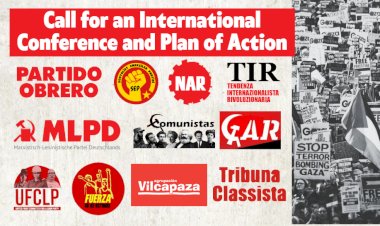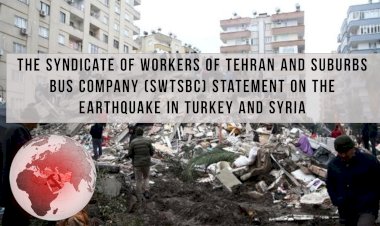End the Trap of Azeri-Armenian Enmity! A Historical Perspective
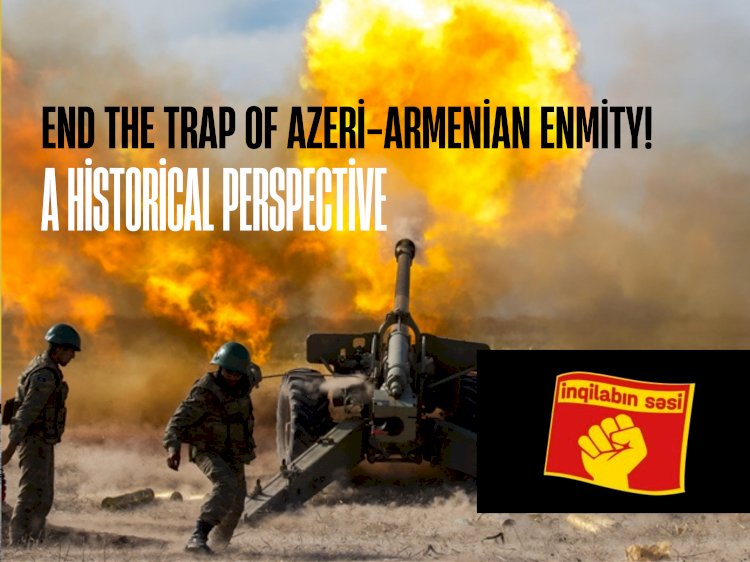
While the workers are exposed to intense exploitation and poverty in a country where human rights and basic democratic rights are smashed, while young people are struggling with unemployment and futurelessness; The Aliyev regime is provoking nationalism and Armenian hatred with its cries of “victory”. The time has come to give the show away.
The peoples of the Caucasus have longed for a classless, borderless, and fraternal life for centuries. Ethnic strife, which local rulers and imperialist powers try to keep warm, prevent by bloodshed and enmity Karabakh has been the center of these ethnic conflicts for centuries. While the working people of both sides are struggling with poverty, the nationalism that is provoked serves the interests of the sovereigns. So, what attitude should the Azerbaijani revolutionaries follow to remove Karabakh from being the Caucasian front of the imperialist war?
The October Revolution and Transcaucasia
From the moment the Revolutionary Soviet Government took power with the October Revolution, all nations in the territory of Tsarist Russia were granted the right to self-determination. However, the path of the revolutionary enthusiasm experienced in the Caucasus, inspired by the October Revolution, the feast of the oppressed, to real liberation and independence was painful and difficult.
A few weeks after Musavat, the representative of the nationalist bourgeoisie came to power and declared its independence, the Ottoman Army entered Azerbaijan and occupied the country. The Ottomans and Germany, who were defeated in WW I, left their sovereignty over Transcaucasia to British rule. Under these conditions, the counter-revolutionary White Army could wage war on the Caucasus front. During the period when the Reds were close to victory over the Whites in the Civil War, in April 1920, the Red Army expelled foreign troops from Azerbaijan and declared the Caucasian city of Baku as the capital of the Azerbaijan Soviet Socialist Republic. Baku had a more organized working class and class struggle experience than other parts of Transcaucasia. Together with Petrograd, Baku was one of the strongholds that did not fall even in the most difficult times and years of reaction following the defeat of the Bolsheviks in the 1905 Revolution. Another significance of Baku, or Azerbaijan in general, is that it plays a bridge role in the opening of an Eastern front in the world revolution. As Trotsky proposed as early as the summer of 1919, an Eastern front had to be opened in the World Revolution, and Asia and the Middle East had to adapt to the radicalization. April 28, 1920, was the opening of the Revolution to the East. Congress of the Peoples of the East convened on September 1, 1920, and created great excitement due to the victories of the anti-colonial and socialist movements in Asia. Mustafa Suphi's Communist Party of Turkey (TKP) was founded in Baku.
The World Revolution Interrupted and The Great Russian Chauvinism
The national question appears as a reality shaped not only by ethnic, religious, or cultural limitations but also by class struggles. This is how Marx and Engels expressed the situation in the Communist Manifesto:
"In proportion as the exploitation of one individual by another will also be put an end to, the exploitation of one nation by another will also be put an end to. In proportion as the antagonism between classes within the nation vanishes, the hostility of one nation to another will come to an end”
Oppositions between ethnic identities are not antagonisms, but emerge as a reflection of irreconcilable class contradictions. If a classless social structure emerges when the main cause, namely class contradiction, is eliminated, the national problem, which is the result, will also be resolved. But the USSR was not moving towards a classless society. The bureaucracy was on its way to making itself dominant as a class. The architects of the October Revolution, Lenin, and Trotsky were aware of this, and they fought for the rest of their lives against the bureaucracy's liquidation of the proletariat organized as the ruling class and establishing its dominance.
As the revolution was trapped in one country and the world revolution did not take place, the established workers' state was pushed toward corruption. As a result of this corruption, a new class, bureaucracy, began to rise. Standing on the shoulders of this bureaucratization, Stalin began to destroy the entire legacy of the October Revolution with a counter-revolutionary process.
Lenin always sympathized with the oppressed peoples and their struggles. The policy of korenizatsiya-localization began to be implemented to revive the national cultures that were suppressed under Tsaristism, which was the prison of the peoples, and to resound the tunes, folk songs, and songs in local languages. Korenizatsiya was of great importance for reversing the policy of Russification, which had been going on for years, and for the awakening of local cultures. Within the framework of the Korenizatsiya policy, the official language of education and state in Azerbaijan became the Azerbaijani language. Among the communists working in the Soviet, those who did not know Azerbaijani were encouraged to learn Azerbaijani. For the union of equal republics, which Lenin accepted as the basic principle, for each nation not to have a hierarchical effect on the other and to ensure real equality, the nations that were exposed to Russification pressure under Tsarist had to be localized by a contrary process. But the counter-revolution of Stalinism would destroy this feast of the oppressed brought by the October Revolution, and turn the struggle for equality and freedom upside down.
As the revolution could not spread, the rising bureaucracy changed the policy of the national question in the opposite direction of Lenin's. The “Great Russian Chauvinism” provoked by the bureaucracy was turning the national question into a dynamite ground that could explode at any moment. Stalin is one of the greatest examples of Great Russian Chauvinism. As long as Lenin lived, he had fought against national chauvinist elements within the party. In the last years of his life, when he could not intervene in the internal party discussions as much as he used to, he wrote in 1922:
“I declare war to the death on Great Russian chauvinism. I shall eat it with all my healthy teeth as soon as I get rid of this accursed bad tooth..”
When Stalin was the Commissar of Nations in the Council of People's Commissars, he prepares a report called “a draft of a resolution concerning relations between the RSFSR and the independent Republics“The draft was prepared based on “official accession of the republics of Ukraine, Belarus, Azerbaijan, Georgia and Armenia to the RSFSR” (Nahoylo ve Swoboda, 1990, s. 50). This draft by Stalin officially made the territories of the republics under the control of the Russian Soviet Federal Republic. Lenin objected to the draft. According to Lenin, a federation should be formed in which all republics were united on an equal basis, and all republics should have equal rights. The Russian Republic was equal and indistinguishable from the others (Lenin, 1973, s. 372).
The final draft of Stalin's commission was prepared according to these criticisms of Lenin, and the Third Congress of Soviets adopted the treaty forming the USSR on December 30, 1922. Lenin was aware of Stalin's national chauvinistic character. In 1919, Lenin wrote, “Scratch some Communists and you will find Great Russian chauvinists."
From the time that Stalin consolidated his power, the understanding of history and the Marxist perspective were changed. Russification policies were revived. While the understanding of history has been emphasizing the actions of the masses from below since the revolution, the emphasis in history books has changed and started to emphasize "national" heroes and their sacrifices for the homeland. This is how the Marxist social scientist Matt Perry described the historical distortion of Stalinism:
“This reversal of Russian nationalism can be illustrated by the example of the great filmmaker Sergey Eisenstein (1898-1948). In his early films, such as Battleship Potemkin (1925), Strike (1925), and October (1927), Eisenstein documented and heroized the revolutionary actions of workers, sailors, and the Petrograd mob. Later epic films such as Alexander Nevsky (1938) and Ivan the Terrible 1 (1945) revived the Patriots' Great War (the phrase used in the Soviet Union to describe World War II) and old nationalist phrases to pay homage to Stalin."
A campaign was launched to restore certain monuments in tsarist history, such as those from the Kulikova war and the Fatherland War, which were seen as symbols of heroism.
Addressing the military units during World War II, Stalin made a speech by commemorating the symbol names known as the self-sacrificing heroes of Tsarist Russia:
"Comrades, Red Army, soldiers of our Red Navy, officers, workers, partisans of men and women!.. your war is a war of freedom, a just war, be inspired by the heroic names of your great ancestors in this war, Alexander Nevsky, Dmitry Donskoy, Minin and Pozharski, Aleksandr Suvorov, Mikhail Kutuzov! May the victorious banner of the great Lenin bless you. Death to the German invaders!”
On May 24, 1945, at the Kremlin invitation for the commanders of the Red Army, Stalin toasted the Russian people:
“I would like to make a toast to the health of the Soviet people, and above all the Russian people. Above all, I drink for the health of the Russian people, because among the nations that made up the Soviet Union, the Russian nation is the foremost nation. I say let's raise a toast to the health of the Russian people, because through this war, among all the peoples of our country, it has won the right to be recognized as the guiding force of the Soviet Union. I would like to make a toast to the health of the Russian people, not only because they are the leading people, but also because they have a clear mind, strong character, and patience. And this faith of the Russian people in the Soviet government was the decisive force that made possible our historic victory over the enemy of humanity, fascism. Thanks to the Russian people for their faith. To the health of the Russian people! (Nahaylo ve Swoboda, 1990, s. 95).”
After the genocides and bloody wars in Czarist Russia, which was the prison of the oppressed nations, even when the socialist workers' state was established, the only way for a representative of the oppressing nation and the representative of the oppressed nation to live together and in the fraternity is to establish equal and free republics. However, if you see Russia as the first and eldest brother among equals; If you commit genocides in republics founded on oppressed nations, you will have destroyed the conditions of fraternal and free living together. But it should not be forgotten that although Stalin's subjective will played a role here, the most important role lies in the objective conditions that created Stalin. Factors such as the world revolution not spreading, the revolution being stuck in one country, and the change in the sociological structure of the working class after the Civil War are the conditions that created Stalinism.
The Great Russian Chauvinism, which we have explained with examples above, also prevented the free and fraternal living conditions in the Caucasus. It is useful to recall the issue emphasized by Marx and Engels in the Communist Manifesto: “In proportion as the exploitation of one individual by another is put an end to, the exploitation of one nation by another will also be put an end to.” During the Stalinist USSR period, class antagonisms were not resolved, and with the consolidation of the new ruling class, the bureaucracy, new conditions of exploitation continued to exist.
Lenin understood very well the dialectical connection between “Great Russian Chauvinism” and “Social Nationalism” and while showing his stance against social nationalism (nationalism of the oppressed nation), he also very clearly expressed his attitude towards Great Russian Chauvinism. On December 1, 1920, a meeting was held under the chairmanship of the Caucasus Director of the Russian Communist Party, Grigori Orjonikidze, with the participation of representatives of Azerbaijan, Armenia, and the Russian Communist Party. Narimanov, the leader of Soviet Azerbaijan under the control of Orjonikidze, declared that he had put an end to the historical conflict between Muslims and Armenians by leaving Zangezur, Nakhchivan, and Nagorno-Karabakh regions to Armenia. The basis of this decision, of which Lenin was also aware, was the fact that the Armenian people lived in the Karabakh region at that time, but the position of the Azeri people was also taken into consideration. As can be seen from the map, the Armenian-dominated areas were given to Armenia, while the Tatars (as the Muslim Azerbaijani people were called at that time) majority areas were given to Azerbaijan. On June 21, 1921, Orjonikidze, in a letter, he sent on the subject, warned Narimanov that "not a single Armenian village should be attached to Azerbaijan, and in the same way, not a single Muslim village should be attached to Armenia." (Barsegov 2008, p. 635)
However, on July 5, 1921, a meeting in the Caucasus Bureau of the Russian Communist Party, attended by Kirov, Orjonikidze, and Narimanov, with the intervention of Stalin, changed the mind in one day. Nagorno-Karabakh was defined as an autonomous region, this time under Azerbaijan. Moreover, while the borders of the region were being drawn, the Lachin region was left to Azerbaijan to cut off Nagorno-Karabakh's physical relationship with Armenia.
One of the most important reasons for this policy of Stalin was that he wanted to see Russia as a controlling device by preventing the free and fraternal coexistence of the peoples of the Caucasus. Lenin thought that Stalin's policy was wrong and he said the following about it:
“It is said that a united apparatus was needed. Where did that assurance come from? Did it not come from that same Russian apparatus which, as I pointed out in one of the preceding sections of my diary, we took over from tsarism and slightly anointed with Soviet oil?
...
I think that Stalin's haste and his infatuation with pure administration, together with his spite against the notorious "nationalist-socialism", played a fatal role here. In politics spite generally plays the basest of roles.”
It was not in the interests of the Stalinist bureaucracy that the peoples of Azerbaijan and Armenia should mingle in a voluntary and equal way. According to Stalin, the Azerbaijan Communist Party and the Armenian Communist Party, like all other CPs, should have acted as puppets in the diplomatic relations of "the motherland Russia". As a result, the “USSR” consisted of four big lies: there was no Unity, no Soviet, no Socialism, and no Republics.
When national antagonisms remain unresolved, the rise of nationalism awaits a mass spark. This spark came when the USSR had lost the Eastern Bloc, and its collapse was almost certain. By 1988, the field of ethnic conflicts, under which social dynamite was laid as a legacy of Stalinism, was ready to explode.
1st and 2nd Karabakh Wars and Post-War Situation
In 1988, the Armenian deputies of the National Council, which formed the administration of Nagorno-Karabakh, demanded that the region be attached to Armenia. This demand was met with rallies and mass demonstrations both in Nagorno-Karabakh and in Armenia. The "Karabakh" and "Krung" committees in Nagorno-Karabakh launched rallies and strikes in early 1988. In response, a pogrom against the Armenians was organized in the Sumgait region of Azerbaijan. According to official documents, 26 Armenians and 6 Azeris died, but according to unofficial documents, more than 200 people died. The assembled Nagorno-Karabakh Autonomous Province of People's Deputies approved the transition of the region to the Republic of Armenia by a majority of votes. This decision was met with the objections of Moscow and Baku. On the other hand, on November 26, 1989, the administration of the Azerbaijan Soviet Socialist Republic abolished the autonomous status of Nagorno-Karabakh and decided to attach the entire administration to Baku. In response to this, the Armenian Supreme Soviet and the National Council, which is the legislative body of Karabakh, declared that the region was united with Armenia 3 days later. In December 1991, when the USSR was officially dissolved, the Armenians decided to establish an independent state as a result of the referendum boycotted by the Azeri minority in Nagorno-Karabakh. (Armenians made up 77 percent of Nagorno-Karabakh's population of nearly 200,000 in 1989, and Azeris made up 23 percent). The war, in which armed conflicts began in 1991, continued with bloody massacres and clashes. On May 5, 1994, a ceasefire was declared in Bishkek, the capital of Kyrgyzstan, with the Bishkek Protocol, signed between the authorities of Azerbaijan, Armenia, Nagorno-Karabakh, and Russia.
Although the ceasefire declared in 1994 was occasionally violated, no major warfare occurred until September 2020. On September 27, 2020, clashes broke out on the borderline established after the 1st Karabakh War. Although the clashes initially took place in the borderline area, the Azerbaijani Army gradually expanded to include 7 districts around Nagorno-Karabakh and Nagorno-Karabakh. Over 5,000 people died in the war. On November 9, 2020, after Shusha came under the control of Azerbaijani Forces, the Armistice Agreement signed by Pashinyan, Aliyev, and Putin was signed. On November 10, 2020, at 00:00 Moscow time, it was announced that all conflicts in Nagorno-Karabakh were ended.
During and after the war, Armenian hatred and nationalism were pumped by the Aliyev regime in Azerbaijan. Workplaces, streets, and schools were filled with photographs of Aliyev raising his fist and saying "Karabakh is Azerbaijan". In the euphoria of victory, the Aliyev regime was trying to produce consent among the people and consolidate its constitutionalism. The people, who were blindly intoxicated for a short time by Aliyev's rhetoric of victory, faced hikes in basic food products and oil prices in Azerbaijan, an oil-rich country. A wave of mass suicides rose among veterans who protested because the post-war government did not deliver on its promises.
The Aliyev regime, which wanted to cover up heavy exploitation conditions and corruption with pumped nationalism, has now finished its trump card after the war. In recent months, couriers from Wolt and Bolt companies launched a boycott in protest of low wages, which lasted for several days. After the boycott, the Courier Union was established and nearly 50 couriers started to fight for the union. The Aliyev regime was afraid and uneasy about the formation of trade union activities that were independent of the state and supported the struggle of the workers.
The regime uses its “iron fist” to stop the unionization among the workers, thus preventing the workers, who have developed class consciousness, from opposing first the boss, then the state, and the system. Unionist courier Orhan Zeynallı was recently detained from his home and brought to the Organized Crime Administration, where he was later sentenced to 30 days in prison. Elvin Feyruzzade and Afiaddin Mammadov, who were union leaders, were also detained by the regime's forces. Although Elvin was released, Afiaddin was sentenced to 30 days in prison. Other workers who participated in the trade union struggle were also dismissed by the Wolt company. This is an indication of how much Aliyev fears rising workers' movements. Aliyev, who knows that he cannot produce consent by getting the workers drunk as before, with nationalism, makes the way out with the repression device and the "iron fist".
Conclusion: What to be done?
As a result, although Azerbaijan is portrayed as the victorious and Armenia as the defeated, the main situation can be summarized as follows: The winner is the imperialist establishment and the local ruling class, and the losing side is the working people of Azerbaijan and Armenia. The budget earned from the sweat of the Azerbaijani workers was allocated for the purchase of weapons from Israel, Turkey, and many imperialist countries, and the lands stained with the blood of the Azerbaijani and Armenian people were given under the service of the Azerbaijani and Turkish bourgeoisie. Karabağ’da açılan yeni şirketler bunun en önemli göstergelerindendir. The only condition for ending the war between Azerbaijan and Armenia and for the peoples to live together freely and fraternally is to give the Caucasus a socialist character. The workers and toilers of Azerbaijan and Armenia have only one way of salvation: the Socialist Caucasian Federation, which will be established based on proletarian internationalism.
The urgent task that stands before the Azerbaijani revolutionaries is to oppose their ruling class, the local bourgeoisie, and the Aliyev regime. We must fight against expansionism and imperialist war. We must fight against the Turkish bourgeoisie, which uses Karabakh to expand its markets, and the AKP, which supports the war logistically, technologically, militarily, and financially. All forms of nationalism must be opposed and nationalist ideology must be fought. The formation of ideological hegemony on nationalism should be replaced by classist and socialist ideology. The idea that war is a necessary tool for the stability of the region should also be opposed, and it should be exposed that wars are permanent unless capitalism is buried in history. We must adopt the slogan of "Permanent Revolution against Permanent War" and fight for a world revolution.
The Azerbaijani and Armenian soldiers fighting in Karabakh should understand the reactionary character of this war and should aim their weapons at their rulers, not against each other. The ruling class does not care about martyrs or veterans but only protects its interests by building companies on their blood and exploiting gas and energy resources. Hence, the slogan to be followed by the soldiers of Azerbaijan and Armenia should be "the real enemy is inside", and the weapons should be directed at the Aliyev regime, the Pashinyan regime, and the imperialists who incite nationalism among the peoples.
Another mistake that Azerbaijani revolutionaries should not make is the stagist program. The stage of democratic capitalism against the dictator Aliyev's regime is a misleading and erroneous understanding. On the way to overthrow the Aliyev dictatorship, it is not necessary to cooperate with the bourgeoisie in any way. Considering the hegemony of monopoly imperialism over the late capitalist countries, the bourgeoisie is no longer a progressive and revolutionary character, as capitalism has established itself worldwide. Because the bourgeoisie does not want the Aliyev dictatorship to be topped, because the Aliyev regime is already protecting the interests of the bourgeoisie.
The Aliyev regime will be destroyed by the working class and the struggle of the futureless youth. The working class can overthrow the regime and make itself dominant as an organized force with the intervention of a leading party. Throughout history, examples from many parts of the world show that, although the working class revolts and creates the power to make a revolution, the absence of a party that will lead the uprising to revolution and power was prevented by the counter-revolution. İnqilabın Sesi was founded based on the fact that there is no leading party in Azerbaijan. Inspired by the Paris Commune, the October Revolution, and comrades Marx, Engels, Lenin, and Trotsky, we say it's time for the class struggle for Azerbaijan again and call to build our party. Organize and join the transformative power of history!
Long Live the Revolutionary Struggle!
Long live the Socialist Caucasus!
One Solution Permanent Revolution!



